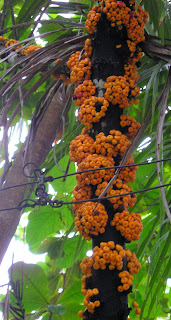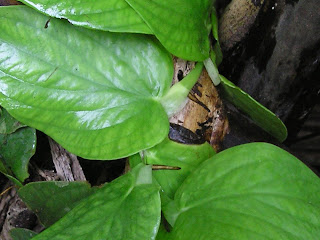
This is a strange fig tree that grows in my garden. The fruit grow directly on the trunk of the tree, in bunches, quite unlike other figs, and the fruit come along every three or four months.
Sometimes birds do try and eat them, but there is not enough surface for them to perch and peck. So I left the coconut frond that fell down to give them some purchase. On a closer look, I found that the yellow figs are unripe. They go dark red as they ripen, and the birds certainly go for those.
I'm interested to see if this fig has a life style dependent on insects, as so many figs do.
Tomorrow (or maybe the next day, life being a little bit lazy) I'll get one of the figs and dissect it.
If there is a story at all, I'll post it here.

[Day 2 Well, it's now tomorrow, and here is a picture of the fruit. The yellow one is unripe, and the red one was very ripe and sticky. I couldn't see any insects in either (some figs have friendly relations with tiny wasps).
Anyway, I ate it, and I'm not dead yet.
By the way, the two wires crossing the photo above are my electricity supply; great bit of junction wiring to the left.
[Day 3] I've now realised that the rest of the world gets up in the morning a lot earlier than I do, so this morning I got up and watched that bloody fig tree.
They're all there, from the sunbirds, to
that-bright-yellow-bird-I-don't-the name-of, to the imported European sparrows (who chat with a Spanish, not a Cockney accent).
Wonderful sight, even through the haze of a normal morning hangover.
DH Lawrence wrote this about figs:
The proper way to eat a fig, in society,
Is to split it in four, holding it by the stump,
And open it, so that it is a glittering, rosy, moist,
honied, heavy-petalled four-petalled flower.
Then you throw away the skin
Which is just like a four-sepalled calyx,
After you have taken off the blossom with your lips.
But the vulgar way
Is just to put your mouth to the crack, and take out the flesh in one bite.
Every fruit has its secret.
The fig is a very secretive fruit.
As you see it standing growing, you feel at once it is symbolic:
And it seems male.
But when you come to know it better, you agree with the Romans, it is female.
The Italians vulgarly say, it stands for the female part; the fig-fruit:
The fissure, the yoni,
The wonderful moist conductivity towards the centre.
Involved,
Inturned,
The flowering all inward and womb-fibrilled;
And but one orifice.
The fig, the horse-shoe, the squash-blossom.
Symbols.
There was a flower that flowered inward, womb-ward;
Now there is a fruit like a ripe womb.
It was always a secret.
That's how it should be, the female should always be secret.
There never was any standing aloft and unfolded on a bough
Like other flowers, in a revelation of petals;
Silver-pink peach, venetian green glass of medlars and sorb-apples,
Shallow wine-cups on short, bulging stems
Openly pledging heaven:
Here's to the thorn in flower! Here is to Utterance!
The brave, adventurous rosaceæI'm sorry, I can't go on with this. It's the plea of a Northern Englishman to a fruit he probably only tasted once in his life. It's nice stuff, but isn't he over-doing it a bit?
Rest of it at
http://www.kalliope.org/digt.pl?longdid=lawrence2001061702
 These are clovisses, or Tapes decussatus. In French T. decussatus is "clovisse" and T. decussatus form fusca "palourde", or Manila Clam, Japonaise, Alemeja. The local name in Siargao is punau.
These are clovisses, or Tapes decussatus. In French T. decussatus is "clovisse" and T. decussatus form fusca "palourde", or Manila Clam, Japonaise, Alemeja. The local name in Siargao is punau.



 This is Sam City - Sana'a, Yemen, from the air. Sana'a must be one of the oldest continually-inhabited cities on earth, and one of the very few that still looks old and timeless.
This is Sam City - Sana'a, Yemen, from the air. Sana'a must be one of the oldest continually-inhabited cities on earth, and one of the very few that still looks old and timeless.



















 We have a couple of 'daily lizards' around the place.
We have a couple of 'daily lizards' around the place.











